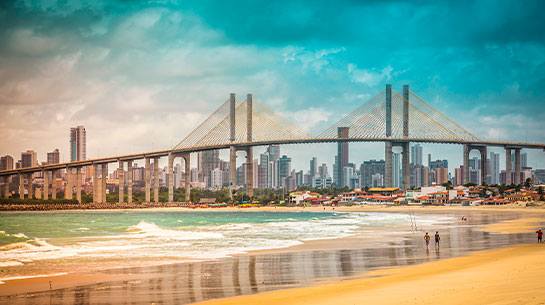- Products and Solutions

Natal: over 400 years of beauty and history
With one of the most beautiful coastlines in Brazil, which extends for over 400 km, Natal is considered the city with the purest air in South America. The most popular beach in the city is Ponta Negra, where locals and tourists enjoy the sea, restaurants and nightlife. The most paradisiacal beaches are in neighboring cities such as Búzios and Barra de Tabatinga to the south of the capital, in addition to the dunes of Genipabu in the north, and Pipa Beach, which is 80 km away.
According to data from 2018 from the Brazilian Institute of Geography and Statistics (IBGE), Natal has 877,640 inhabitants in an area of 172 square kilometers. It is there that the Companhia Energética do Rio Grande do Norte (Cosern), company of the Neoenergia Group , operates to supply energy for 1.47 million customers. Cosern is among the best distributors in the country, according to Abradee research, and is recognized in Rio Grande do Norte as the company that invests the most in potiguar culture.
GET TO KNOW THE HISTORY OF NATAL
Founded in 1599 on the banks of the Potengi River, Natal emerged from the Spanish intention to expel the French from the Brazilian coast during the period of the Union of Iberian Crowns (1580-1640). The King of Spain, Felipe II, ordered the construction of a fortress to protect Barra do Rio Grande - as the territory was called at that time - and the foundation of a city a mile from the fortification.
The Fortaleza dos Santos Reis, also called the Fortaleza dos Reis Magos, was inaugurated in January 1598, and its name refers to the Kings Day, when the Christmas cycle ends. Almost two years later, within a mile of the building, the city was born, whose boundaries were demarcated on December 25, 1599.
Natal was a small town, a few kilometers long. It began on the outskirts of present-day Praça das Mães and ended at Praça da Santa Cruz da Bica, both located in Cidade Alta. The beginning and the end of the city were marked by two crosses - to this day, a symbolic cross is still preserved in Praça da Santa Cruz da Bica.
In the first 100 years of its existence, Natal grew slowly. By the end of the nineteenth century, however, the city already had a population of over 16,000 inhabitants. From 1922, the development of Natal gained pace with the emergence of the first urban activities. Another event that marks a new phase in the capital is Brazil's entry into World War II in 1942 alongside the United States. Natal now has an American base that attracts investments and a population of 10 thousand American soldiers - increasing the local population by 20%.
News
2025-04-22
Neoenergia vende 50% de Itabapoana Transmissão
2025-04-15
Nova campanha da Neoenergia celebra a potência feminina no esporte e reforça apoio às atletas embaixadoras da marca
2025-03-27
Instituto Neoenergia lança chamada inédita unificada de editais para apoiar projetos sociais
2025-03-21
Neoenergia é reconhecida entre as empresas mais exemplares do mundo em sustentabilidade
2025-03-14
